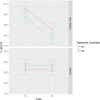A randomized waitlist-controlled trial comparing detached mindfulness and cognitive restructuring in obsessive-compulsive disorder
- PMID: 30893353
- PMCID: PMC6426247
- DOI: 10.1371/journal.pone.0213895
A randomized waitlist-controlled trial comparing detached mindfulness and cognitive restructuring in obsessive-compulsive disorder
Abstract
Objective: Whereas research has demonstrated the efficacy of cognitive restructuring (CR) for obsessive-compulsive disorder (OCD), little is known about the efficacy of specific metacognitive interventions such as detached mindfulness (DM). Therefore, this study compared the efficacy of CR and DM as stand-alone interventions.
Design: We conducted a randomized waitlist-controlled trial. n = 43 participants were randomly assigned to either DM or CR. Out of those participants, n = 21 participants had been previously assigned to a two-week waitlist condition.
Materials and methods: In both conditions, treatment comprised four double sessions within two weeks. Assessment took place at baseline (Pre1), after treatment (Post) and four weeks after the end of treatment (FU). There was a second baseline assessment (Pre2) in the waitlist group. Independent evaluators were blinded concerning the active condition. Adherence and competence ratings for the two therapists were obtained from an independent rater.
Results: 40 patients completed the treatment. Two patients dropped out because of exacerbated depression. There were no further adverse events. Both CR and DM were shown to be superior to waitlist and equally effective at reducing OCD symptoms from pre to post assessment as measured with the Y-BOCS (CR: d = 1.67, DM: d = 1.55). In each of the two treatment conditions, eight patients (40%) exhibited a clinical significant change at post assessment.
Conclusions: The results of this clinical trial suggest the potential efficacy of DM as a stand-alone intervention for OCD, however, our findings need to be interpreted with caution. Results indicate that both CR and DM should be considered as possible alternative treatments for OCD, whereas the working mechanisms of DM have yet to be elucidated.
Conflict of interest statement
The authors have declared that no competing interests exist.
Figures


Similar articles
-
Comparing effects of detached mindfulness and cognitive restructuring in obsessive-compulsive disorder using ecological momentary assessment.Clin Psychol Psychother. 2020 Mar;27(2):193-202. doi: 10.1002/cpp.2418. Epub 2020 Jan 13. Clin Psychol Psychother. 2020. PMID: 31881096 Clinical Trial.
-
Mindfulness-based cognitive therapy as an augmentation treatment for obsessive-compulsive disorder.Clin Psychol Psychother. 2017 Sep;24(5):1109-1120. doi: 10.1002/cpp.2076. Epub 2017 Feb 13. Clin Psychol Psychother. 2017. PMID: 28194835
-
Mindfulness-based cognitive therapy in obsessive-compulsive disorder: protocol of a randomized controlled trial.BMC Psychiatry. 2014 Nov 18;14:314. doi: 10.1186/s12888-014-0314-8. BMC Psychiatry. 2014. PMID: 25403813 Free PMC article. Clinical Trial.
-
[Mindfulness-based interventions in obsessive-compulsive disorder: Mechanisms of action and presentation of a pilot study].Encephale. 2017 Dec;43(6):594-599. doi: 10.1016/j.encep.2016.10.004. Epub 2016 Nov 22. Encephale. 2017. PMID: 27887679 Review. French.
-
Mindfulness as a therapeutic option for obsessive-compulsive disorder.Expert Rev Neurother. 2024 Aug;24(8):735-741. doi: 10.1080/14737175.2024.2365945. Epub 2024 Jun 18. Expert Rev Neurother. 2024. PMID: 38889066 Review.
Cited by
-
Worry Postponement From the Metacognitive Perspective: A Randomized Waitlist-Controlled Trial.Clin Psychol Eur. 2024 Jun 28;6(2):e12741. doi: 10.32872/cpe.12741. eCollection 2024 Jun. Clin Psychol Eur. 2024. PMID: 39119056 Free PMC article.
-
Effects of Detached Mindfulness on Patients with Obsessive-Compulsive Disorder.Alpha Psychiatry. 2024 Jan 1;25(1):88-93. doi: 10.5152/alphapsychiatry.2024.231385. eCollection 2024 Jan. Alpha Psychiatry. 2024. PMID: 38799502 Free PMC article.
-
Clinical advances in obsessive-compulsive disorder: a position statement by the International College of Obsessive-Compulsive Spectrum Disorders.Int Clin Psychopharmacol. 2020 Jul;35(4):173-193. doi: 10.1097/YIC.0000000000000314. Int Clin Psychopharmacol. 2020. PMID: 32433254 Free PMC article. Review.
-
Metacognitive Therapy in Patients with Obsessive-Compulsive Disorder: A review.Alpha Psychiatry. 2022 Sep 1;23(5):212-216. doi: 10.5152/alphapsychiatry.2022.22840. eCollection 2022 Sep. Alpha Psychiatry. 2022. PMID: 36426268 Free PMC article. Review.
-
Participant perspectives on the acceptability and effectiveness of mindfulness-based cognitive behaviour therapy approaches for obsessive compulsive disorder.PLoS One. 2020 Oct 21;15(10):e0238845. doi: 10.1371/journal.pone.0238845. eCollection 2020. PLoS One. 2020. PMID: 33085672 Free PMC article.
References
-
- American Psychiatric Association. Statistical Manual of Mental Disorders (DSM-5) 5th ed. Arlington, VA: American Psychiatric Association; 2013.
-
- National Institute for Health and Clinical Excellence. Obsessive compulsive disorder: Core interventions in the treatment of obsessive-compulsive disorder and body dysmorphic disorder National Clinical Practice Guideline Number 31. Leicester, London: The British Psychological Society and The Royal College of Psychiatrists; 2006. - PubMed
-
- Wells A, Matthews G. Attention and emotion: A clinical perspective Hove, UK: Erlbaum; 1994.
Publication types
MeSH terms
LinkOut - more resources
Full Text Sources
Medical

